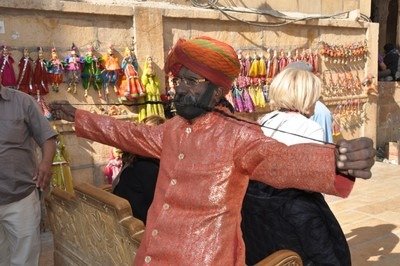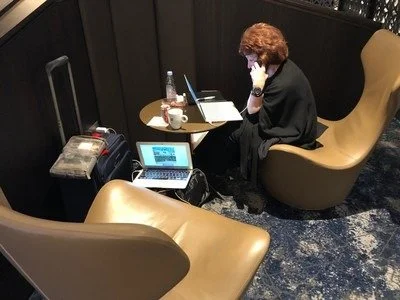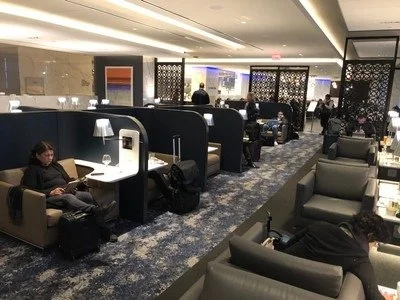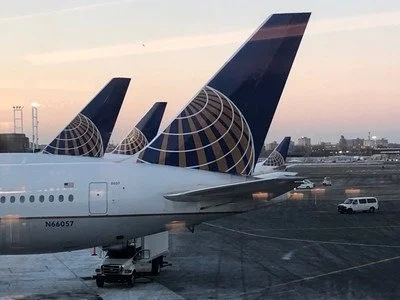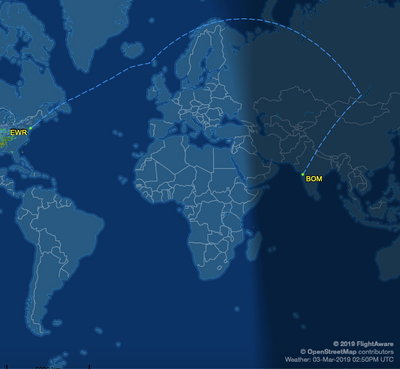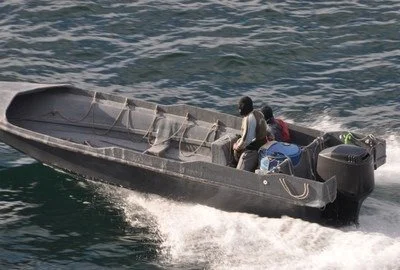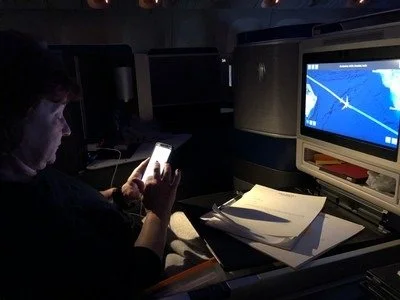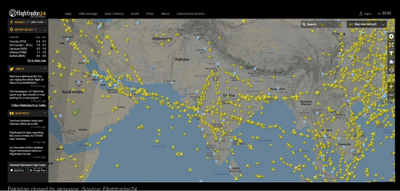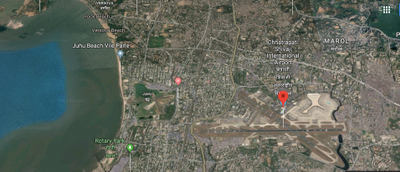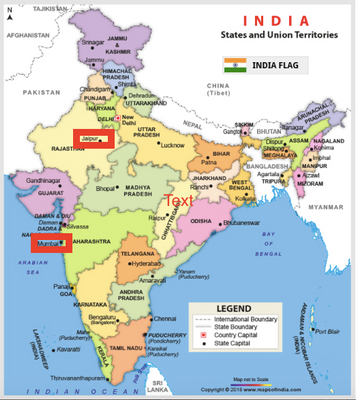Crashing the Wedding (Not the Plane)
Flying over Pakistan is not currently recommended
05.03.2019 - 06.03.2019 20 °F
Plan a trip to India from Kansas City and you will discover that, unless you fly on United Airlines, there is no efficient way to do it. B4 and I are both “3 Million Milers” on American and “1 Million Milers” on Delta and Zero-Milers on United. As a result, because United is not important to us, we are not important to United--even today as we spend a bundle to fly halfway around the world to be a part of a wedding. It is an understatement to say that this is not our normal trip nor travel plan. Read on to see why.
Today, Tuesday, March 5, 2019, we’re off on our non-stop 12:20 CST three-hour flight to Newark International Airport arriving at 4:15pm EST. United Express 3565 is an Embraer ERJ-170, a single-aisle, 70 seat jet operated by Indianapolis-based Republic Airlines, a regional operator that also flies jets under the banners of American Eagle and Delta Connection—950 flights each day.
Upon arrival at Newark’s Liberty International airport, we must wait--for B4 that means work--for almost four hours.
(I’m glad we didn’t arrive here on Sunday because that’s the day that two Southwest 737 jets, following de-icing procedures, ever so slightly collided with one another (below, right). I picked this photo up from Twitter; it sure tells the story)
But, waiting when you are flying in United’s “International Polaris Business Class” means that you get access to the new United Polaris Lounge. Here, you may "dine in the pre-flight dining room" (nothing fancy) or "lounge in the chaise-equipped rest area" (also nothing fancy). Whichever you choose, you are even encouraged to "take a complementary bottle of water with you" as you make your way to the gate (as if there aren’t bottles of water for the aircraft’s business class customers on board?)
From Newark to Mumbai, United 48 is a Boeing 777-300ER which seats 366 people; 60 in “Polaris Business” class, 102 in economy plus class and 204 more in coach class. We depart Newark (code: EWR) at 8:10pm Eastern Standard Time and fly all night long to Mumbai, India, to arrive at 9:40pm India Standard Time the next evening. Mumbai is 11:30 hours ahead of Kansas City. Said another way, from a time standpoint, it is about as close to being precisely on the other side of our globe as you can get.
Our flight is scheduled to take 15 hours. But, currently, it flies a circuitous, non-direct-line route for political reasons. There’s a war on; sort of.
We could fly (see flight map below which is this flight on March 3)
over the North Atlantic, the northern tip of Ireland, across Norway, Sweden and Finland, over a great deal of Russia, and then out of our way to sharply and abruptly turn back southwest over Mongolia, China, Nepal and then into India. That way, we avoid the shorter route of airspace over Kazakhstan, Kyrgyzstan, Tajikistan Uzbekistan, Turkmenistan, Afghanistan and Pakistan.
Or, we could fly (see flight map at right which is this flight on March 2) over southern Europe, then Turkey, just beyond the eastern tip of war-torn Syria, tight-roping down the Iraq/Iran border, over the Persian Gulf, over the Strait of Hormuz, (where I was once ‘buzzed’
[this is a photo from that 2011 encounter] by what I assumed to be a zodiac from the Iranian Navy manned by masked sailors), over the Gulf of Oman, over the open Arabian Sea and then into Mumbai. This is the path we take tonight. B4, working, is oblivious as I watch the map and she congratulates top salespersons and managers across her enterprise with handwritten notes. They'll never know these notes were penned and signed over the Atlantic, Europe, the Middle East and finally, the Arabian Sea.
On Sunday night, 48 flew a still different route as it dipped south and flew over Egypt and Saudi Arabia en route to the Persian Gulf. Tonight, who knows?
United has warned us that we could experience “extended flight times.” Last week the flight we are on was diverted to Frankfurt once and cancelled once. The return flight (United 49) which we will fly coming home was cancelled twice last week and had to stop for extra fuel in Bangor three times and Munich once due to the lengthened flight path. Bloomberg reports that a flight such as ours incurs extra fuel costs of about $90,000 for a delay of only approximately 20 minutes. Wow.
I understand the ‘why’ of all this. Among many issues, the most pressing may be that there is an ongoing ‘crisis’ between Pakistan and our destination India. Last week, these two nuclear-weapon-capable nations were on the “brink of war,” as the New York Times reported. "Tens of thousands of troops have been rushed to the countries’ border, heavy artillery barrages and gunfire have been volleyed across it, and tank columns have been chugging into place for what many feared could turn into a full-blown war.” United did not warn us about any of that.
I am delighted that we are not going to over-fly such a place as that at such a time as this. United is not alone. Pakistani airspace has been closed. Just look at this Flightradar map (below right).
Bloomberg reports that United along with Air Canada, Thai, Qantas, Singapore Airlines and others have diverted planes and canceled trips because of the conflict. All flights between Beijing and Pakistan were cancelled for a couple of days last week.
Remember, if you will, that it was a mere five years ago this July when Malaysia Airlines Flight 17, a Boeing 777 similar to this one, flying from Amsterdam to Kuala Lumpur, was struck by a Soviet-made Buk surface-to-air missile near Donetsk, Ukraine. 283 passengers (80 of them children) and 15 crew perished. For the record, out flight path is either well north or well south of that location.
Also, for the record, I have not and will not discuss this with B4 unless she brings it up which I fervently hope she does not; nothing good can come of that. She can learn about it all as you just did by reading about it here.
She works through the night--and day--( as she always does) while I sleep (which I almost always do). Even as we vacation, the CEO inside B4 is never far from analysis, leadership, thoughtfulness and dedication. You should have seen her during our recent "vacation" to Cabo San Lucas. While five of us lounged by the pool, B4 was at the dining room table, her laptop open and online, her papers neatly organized and her iPhone plugged in so as to not lose its charge as she waded through call after conference call after text. On this trip, she has a satchel full of papers to deal with along with several projects to complete on her laptop.
But back to our flight. According to Flightaware.com, on Tuesday, February 26, our flight was over eastern Russia on its normal direct route to Mumbai when it was abruptly diverted and, instead of continuing on to Mumbai, flew to Frankfurt, Germany, instead. That is the day that the aforementioned Indian fighter flew into Pakistan and attacked the town of Balakot which the Indian government said is a training camp for terrorists who staged a Valentine’s Day suicide bombing in southern Kashmir that resulted in at least 40 deaths. The next day, Pakistani and Indian fighter jets engaged in the skirmish where one "vintage" Indian "aging Soviet-era" MiG-21 jet was shot down by an US-made Pakistani F-16 fighter; the Pakistanis captured (and later repatriated) its pilot. The New York Times reports that Pakistan's use of the plane, "might have been a violation of the sales agreement," it signed when we sold it the aircraft.
These ongoing tensions are but the latest chapter in tensions that began over 70 years ago when the partition of British India took place. Watch the 1982 movie “Gandhi” (it won eight Academy Awards including one for Best Picture) for a Hollywood (not Bollywood) take on what happened. Also, remember that there is a presidential election coming up in India where India’s prime minister Narendra Modi is up for re-election. Nothing so unites a people as the popular outrage and national fervor that comes from being attacked by a foreign power.
To sum up, for us, flying over a newly activated near-war zone is not recommended. United seems to agree. As do I.
Most of our fellow passengers are seemingly oblivious to all of this, paying more attention to the inside of the plane than to what lies beneath it. Our Polaris Business Class seats (3D and 3G—next to each other in the middle of this two-aisle wide-body aircraft) are two of sixty “Business Class pods” containing a 180-degree flat-bed seat that, when reclined, measures 6’6” long and 23 inches wide. There is storage space, multiple surfaces for “stuff,” A/C power, two USB ports, a 16-inch high-def TV screen, and an electronically operated privacy divider between our seats, mood lighting and a lighted “Do Not Disturb” sign to keep intrusive flight attendants at bay. You can sleep or stretch your legs and walk to the marble-topped bar unit to grab a drink or a snack.
We get a choice of blankets: a Saks Fifth Avenue quilted duvet or a lighter-weight throw blanket. There are pajamas available and “cooling gel memory foam pillows.” And, of course, there is food: two meals. Dinner is offered after takoff on “new china with a signature design” and breakfast/lunch before arrival. That’s a lot of sustenance but we need a lot crossing over nearly a dozen time zones. Our arrival at Chhatrapati Shivaji Maharaj International Airport, Mumbai, India, (The airport is named for a Maratha warrior king from the 17th century) is scheduled for 9:40pm on Wednesday, March 6—remember that we left at 8:10pm on Tuesday, March 5.
The trick to flying overseas, in my opinion, is to immediately upon boarding the flight reset your watch for "destination" time. That means that as I settle into my seat at 8:00pm, I reset my watch for 5:30am. I tell my body that it is now 5:30 in the morning. I will try to stay awake for a good long time and then take an "afternoon nap" of a few hours. Otherwise, when we arrive at our hotel in Mumbai at 10:30 or so "tonight" my body will still think it is 10:00 in the morning and will not allow sleep. It's complicated, it's hard and it's something with which you must deal or your first few days of a journey to the other side of the world is lost to fatigue and confusion. I'll keep you posted on how the jet lag goes. The most unique thing about the flight, however, is that the seat belts include--for the first time in my experience--shoulder belts.
As we finally approach Chhatrapati Shivaji Maharaj International Airport, the lights--or lack of them--reveal that the east end of runway 27 is about 1.5 miles from the beach on the Arabian Sea. At night, the sea is pitch black. The airport is surrounded on two other sides by slums
Our flight, wheels up to wheels down was a comparatively short 13 hours and 35 minutes tonight. We were aided by tailwinds of up to 152 mph at altitudes ranging from 31,000 feet to 37,000 feet with outside temperatures measured at 80 below zero. Only a couple of times did turbulence become an issue.
Chhatrapati Shivaji Maharaj is the 29th busiest airport in the world by passenger traffic (almost 50 million annually) despite having only one runway suitable for widebody aircraft. It accommodates nearly 1,000 aircraft movements per day. That is about 42 takeoffs or landings per hour or, said another way, one every 86 seconds. It's a busy place.
Our Terminal 2 (all international flights depart and originate from this building) has been open for only five years and boasts 72 gates and 76 immigration counters for arriving passengers—such as B4 and me. It is organized and clean and orderly; not at all what I expected.
And, you may finally be asking, why are we doing all of this?
Jewelry CEO B4 is an invited guest to one of the two biggest wedding ceremonies to happen in India since, well, since maybe ever. Your humble blog author is but her “plus one.” Much more will be written about the wedding in later installments of this blog.
After we collect our checked baggage and present our passports and Indian visas for inspection (as Americans, we must apply for and pay $160 and be granted an Indian visa or we cannot enter the country), we are met outside customs--where B4 is stopped for having too much jewelry to be a mere tourist (these items must be samples says the customs officer--and immigration by a friendly face—that of Aashish Jhaveri of Rosy Blue, Inc., one of B4’s valued and respected vendors and a representative of the father of the bride-to-be. A friendly face is of unimaginable worth as one enters the mayhem that is the rule for virtually every international airport to which I have traveled (and that is well over 100 of them). The surprise for me is that both dear friend Bobby and diamond guru Boris are both there to greet us as well. We have arrived.
Aashish has a car and driver and gets us to our destination: The Hotel BKC Trident, Bandra Kurla. By road the hotel is a mere four miles or so from the terminal; as the crow flies it is less than two miles south of the terminal. This short drive takes 15 minutes. I wonder how long it would take during “rush hour.” As we will spend five nights in a “Club Room” here, I will have more to say about this hotel and other lodgings on subsequent entries in the days that follow. From checking the map, I do note that at this property, we are right across the street from the U.S. Consulate General. The ambassador to India, of course, would be 870 miles north of here in New Delhi, the capital of this country of 1.3 billion people.
Our bodies are confused if our minds are not. It is approaching midnight but we feel as if we are approaching noon. I have written too much. It is time to force sleep. But, instead, a gathering is scheduled for the hotel bar. Joining Boris and Bobby and B4 and I is Elliott and we talk business until nearly one in the morning. Mined vs. lab, carat weights, colored stones, more and more and more.
